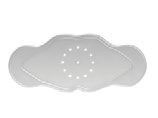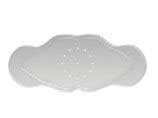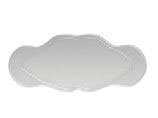
WHAT IS AN ORAL OBTURATOR?
The oral obturator is used to obturate the oral cavity and gradually impede mouth breathing, which may cause malocclusion as well as relapse after orthodontic treat-ment. The device is a simple shield that progressively impedes the flow of air through the oral cavity, thereby aiding mouth-breathing patients.
It has been especially designed to adapt itself to the shape of the dental arches and works as a seal that prevents mouth breathing. The oral obturator features a peripheral rim portion –extending around the upper and lower end- to allow the patient to exercise the labial muscles, which are very important for normalisation of nasal breathing.
There are three types of obturators -permeable, semi-permeable and impermeable- depending on whether they include large breathing holes, small holes, or no holes at all. Each type of obturator comes in six sizes.
- Permeable oral obturator, featuring large breathing holes to allow limited air flow.

- Semi-permeable oral obturator, including smaller breathing holes to control and limit and limit air flow through the mouth even further.

- Impermeable oral obturator, with no breathing holes to totally impede air flow through the mouth.

INDICATIONS
Oral obturators are indicated for mouth-breathing patients, to aid in normalising the breathing problem by means of progressive respiratory re-education to correct mouth breathing and promote nasal route breathing.
Only a licensed dentist may perform a complete evalu-ation of each case history and prescribe the use of this device, whether it is used alone or in combination with other devices.
WHEN AND HOW TO USE AN ORAL OBTURATOR?
Oral obturators are used in combination with nasal stimulators to avoid producing a “suffocating” effect in the patient. Their use is also recommended once the physi-ological causes of mouth breathing have been eliminated: rhinitis, nasal septum deviation, hypertrophic adenoids or tonsils, among the most frequent causes.
Guidelines to ensure that the oral obturator is correctly used:
1. The dental arch perimeter between the first permanent molars measurement is taken from the patient’s mouth or from the mold of the patient’s dental configuration.
2. The adequate oral obturator size is chosen based on this measurement. In case of doubt, select a smaller device than your measured size.
3. Use a permeable obturator to initiate the respiratory pattern normalisation process. It is essential to combine the use of the obturator with the nasal stimulator.
4. The obturator is placed by the patient in the buccal vestibule, between the dental arches, and the lips and cheeks. A night-time regimen is indicated, and if the patient experiences discomfort when using the device at first, the patient should be instructed to wear it at home during the day to get used to it.
5. If the patient has already adapted to using the permeable obturator, after three or four months the patient is instructed to use the semi-permeable obturator.
6. After three or four months of using the semi-permeable obturator, the patient is ready to use the impermeable device.
7. The improvement in labial competence will be also clinically evaluated, and if full recovery of labial competence is not achieved, then the lip stimulator must be used.
8. This medical device may be used in combination with fixed orthodontic appliances.
SIZES
Oral obturators come in 6 sizes (numbered from 1 to 6): the three first sizes are typically used in the pediatric population, while the remaining sizes have been designed for use in adult patients.
Since oral obturators work passively, that is to say, without exerting any force since its main objective is to gradually reduce the passage of air through the mouth, it is very important to select the right size.
